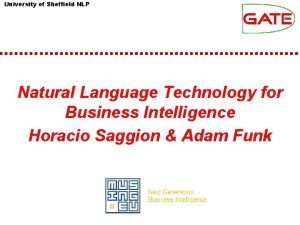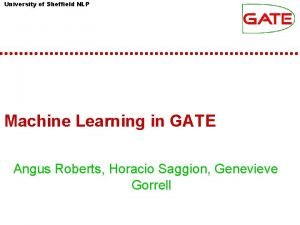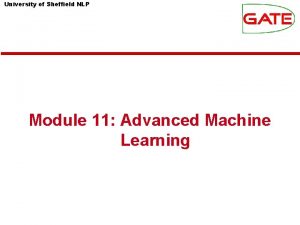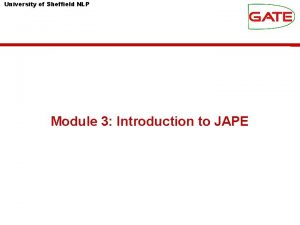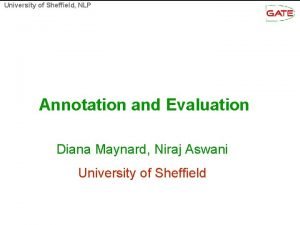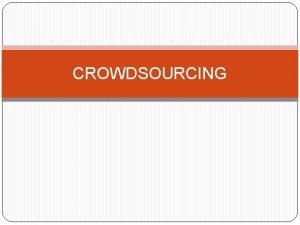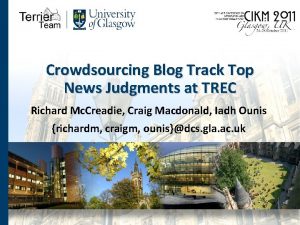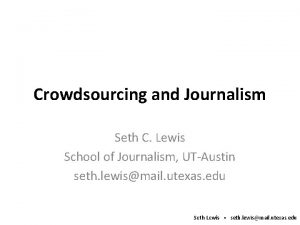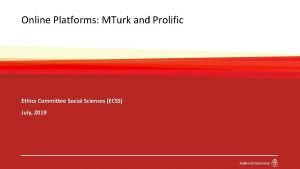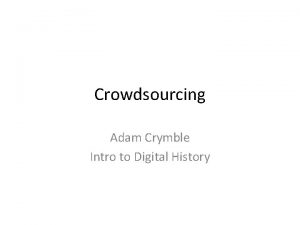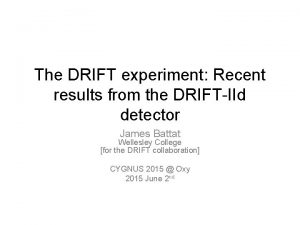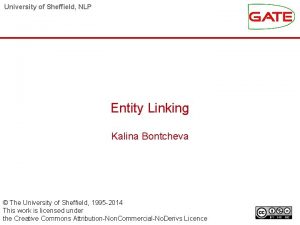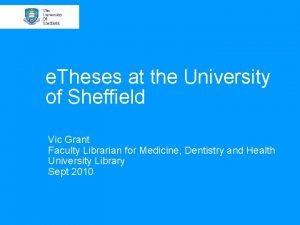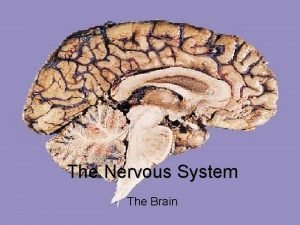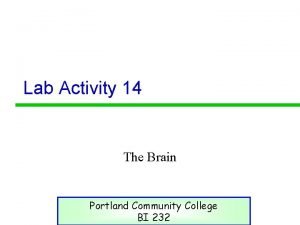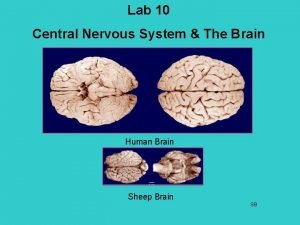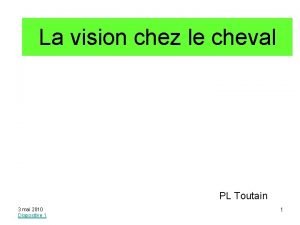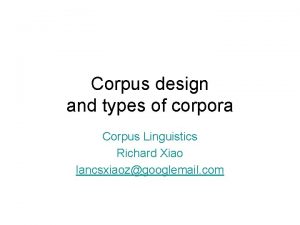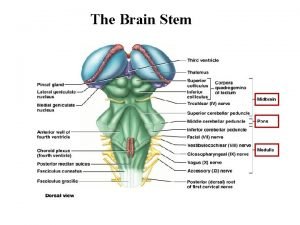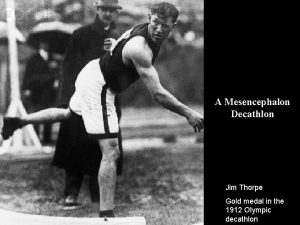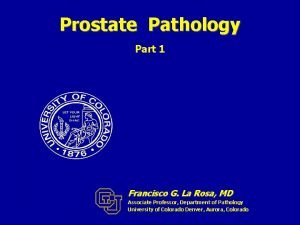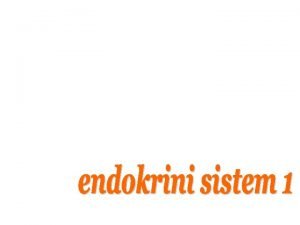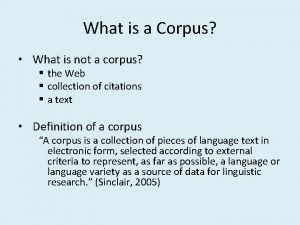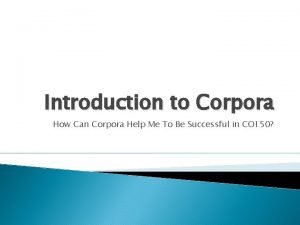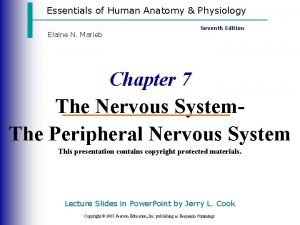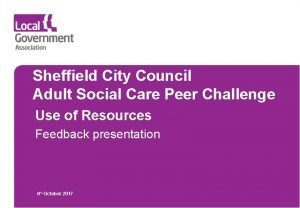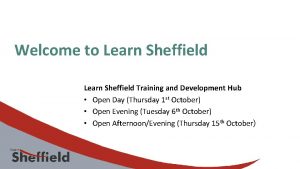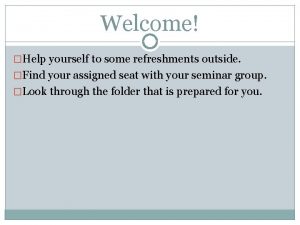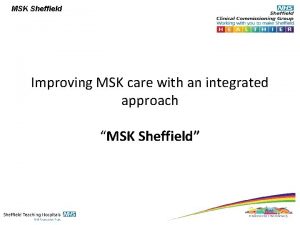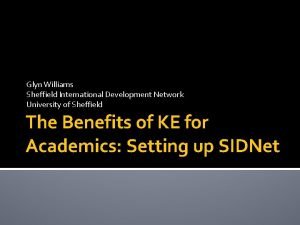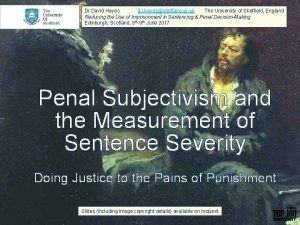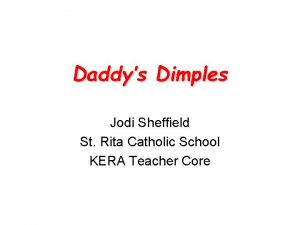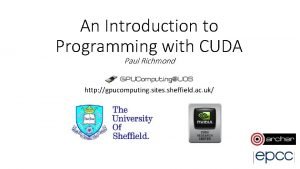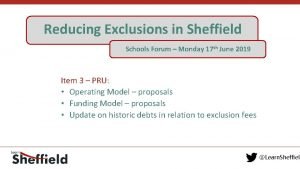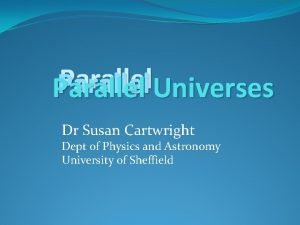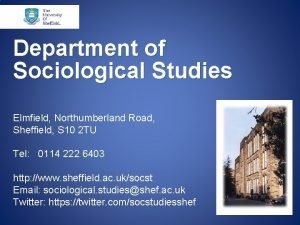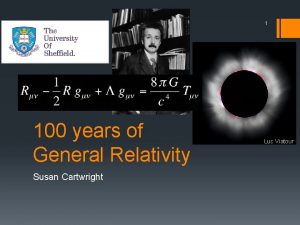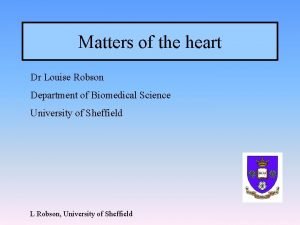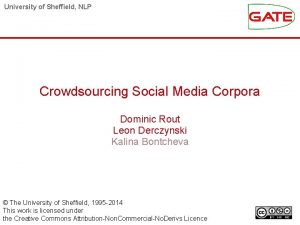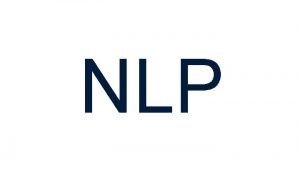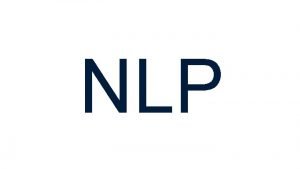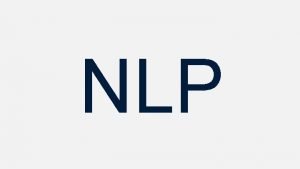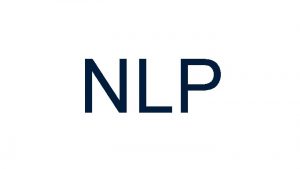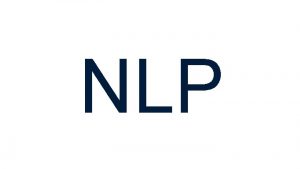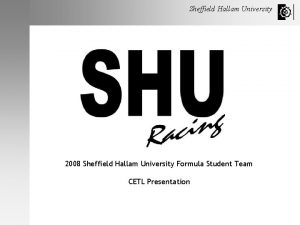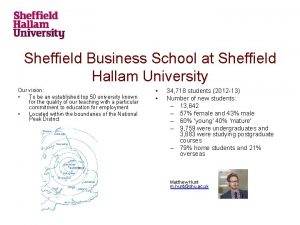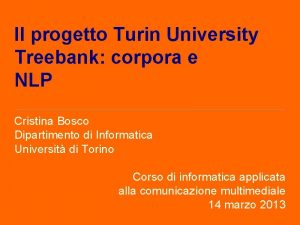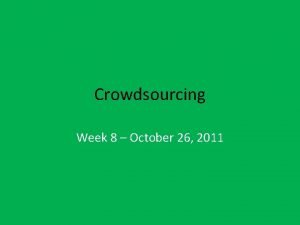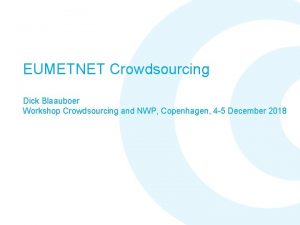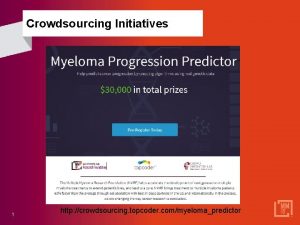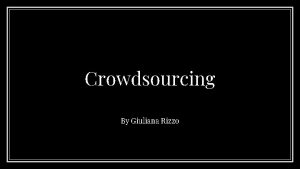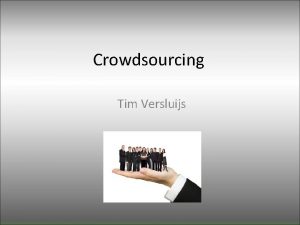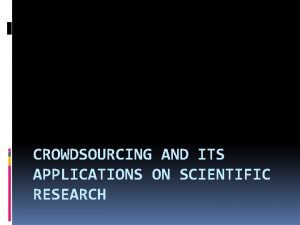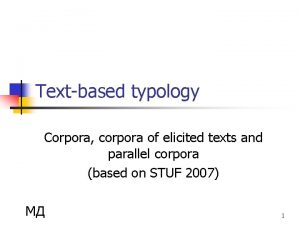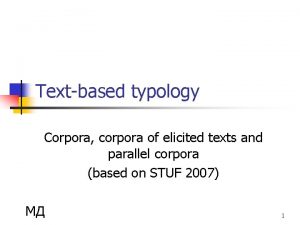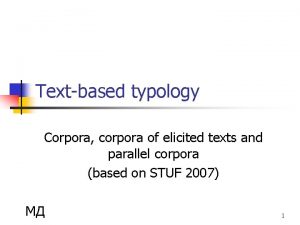University of Sheffield NLP Crowdsourcing Social Media Corpora

















































- Slides: 49

University of Sheffield, NLP Crowdsourcing Social Media Corpora Kalina Bontcheva Leon Derczynski © The University of Sheffield, 1995 -2014 This work is licensed under the Creative Commons Attribution-Non. Commercial-No. Derivs Licence

University of Sheffield, NLP Why Annotate New Social Media Corpora? • Plenty of already annotated corpora in the news and similar genres • Big enough for both training and evaluation • Social media corpora annotated for many NLP tasks are unfortunately largely lacking or too small in comparison to their news counterparts • We will look into how best to create these in an affordable manner • LREC 2014 paper: “Corpus Annotation through Crowdsourcing: Towards Best Practice Guidelines” Sabou, Bontcheva, Derczynski, Scharl

University of Sheffield, NLP The Science of Corpus Annotation • Quite well understood best practice in how to create linguistic annotation of consistently high quality by employing, training, and managing groups of linguistic and/or domain experts • Necessary in order to ensure reusability and repeatability of results • The acquired corpora are of very high quality • Costs are unfortunately also very high: estimated at between $0. 36 and $1. 0 (Zaidan and Callison-Burch, 2011; Poesio et al. , 2012)

University of Sheffield, NLP What is Crowdsourcing? • Crowdsourcing is an emerging collaborative approach for acquiring annotated corpora and a wide range of other linguistic resources • Three main kinds of crowdsourcing platforms • paid-for marketplaces such as Amazon Mechanical Turk (AMT) and Crowd. Flower (CF) • games with a purpose • volunteer-based platforms such as crowdcrafting

University of Sheffield, NLP Why Crowdsourcing? • Paid for crowdsourcing can be 33% cheaper than in-house employees when applied to tasks such as tagging and classification (Hoffmann, 2009) • Games with a purpose can be even cheaper in the long run, since the players are not paid. • However cost of implementing a game can be higher than AMT/CF costs for smaller projects (Poesio et al, 2012) • Tap into the large number of contributors/players available across the globe, through the internet • Easy to reach native speakers in various languages (but beware Google translate cheaters!)

University of Sheffield, NLP Genre 1: Mechanised Labour • Participants (workers) paid a small amount of money to complete easy tasks (HIT = Human Intelligence Task)

University of Sheffield, NLP Paid for Crowdsourcing • Contributors are extrinsically motivated through economic incentives • Carry out micro-tasks in return for micro-payments • Most NLP projects use crowdsourcing marketplaces: Amazon Mechanical Tutk and Crowd. Flower • Requesters post Human Intelligence Tasks (HITs) to a large population of micro-workers (Callison-Burch and Dredze, 2010 a) • Snow et al. (2008) collect event and affect annotations, while Lawson et al. (2010) and Finin et al. (2010) annotate special types of texts such as emails and Twitter feeds, respectively. • Challenges: • low quality output due to the workers’ purely economic motivation • high costs for large tasks (Parent and Eskenazi, 2011) • ethical issues (Fort et al. , 2011)

University of Sheffield, NLP Genre 2: Games with a purpose (GWAPs)

University of Sheffield, NLP Games with a Purpose (GWAPs) • In GWAPs (von Ahn and Dabbish, 2008), contributors carry out annotation tasks as a side effect of playing a game • Compared to paid-for marketplaces, GWAPs: • reduce costs and the incentive to cheat as players are intrinsically motivated • promise superior results, due to motivated players and better utilization of sporadic, explorer-type users (Parent and Eskenazi, 2011) • Example GWAPs: • • Phratris for annotating syntactic dependencies (Attardi, 2010) Phrase. Detectives (Poesio et al. , 2012) to acquire anaphora annotations Sentiment Quiz (Scharl et al. , 2012) to annotate sentiment http: //www. wordrobe. org/ - A collection of NLP games incl. POS, NE • Challenges: • Designing pealing games and attracting a critical mass of players are among the key success factors within this genre (Wang et al. , 2012)

University of Sheffield, NLP Genre 3: Altruistic Crowdsourcing

University of Sheffield, NLP Workflow for Crowdsourcing Corpora 1. Project Definition 2. Data and UI Preparation 3. Running the Project 4. Corpus Delivery

University of Sheffield, NLP Step 1. Project Definition • Data distribution: how “micro” is each microtask? • Long paragraphs hard to digest, worker fatigue • Single sentences not always appropriate: e. g. for co-ref • Reward scheme • Granularity – per task? Per set of tasks? High scores? • What to do with “bad” work • How much to reward • No clear, repeatable results for quality: reward relation • High rewards get it done faster, but not better • Pilot task gives timings, so pay at least minimum wage

University of Sheffield, NLP Step 1. Project Definition • Choose the most appropriate genre or mixture of crowdsourcing genres • Trade-offs: Cost; Timescale; Worker skills • Pilot the design, measure performance, try again • Simple, clear design important • Binary decision tasks get good results

University of Sheffield, NLP Step 1. Project Definition • Named entity recognition example: • • • Entity selection options • Allow users to select entities with the mouse • Ask users to click on the words which constitute the entity • Show users a highlighted entity in context and ask them to classify its type Task definition options • Ask users to classify entities into 4 -7 pre-defined classes simultaneously • Focus on one entity class only, e. g. locations, and ask users to mark only these Distinguish tweets with no entities from tweets where user has not marked anything

University of Sheffield, NLP Step 2: Data and UI Preparation • Pre-process the corpus linguistically, as needed, e. g. • Tokenise text if user needs to select words • Identify proper names/noun phrases if we want to classify these • Bring additional context, if needed, e. g. text of user profile from Twitter • Build and test the user interfaces • Easy to medium difficulty in AMT/CF and crowdcrafting • Medium to hard for GWAPs • Run bigger pilot studies with volunteers to test everything and collect gold units for quality control later

University of Sheffield, NLP Step 2: Data and UI Preparation

University of Sheffield, NLP Step 3: Running the Crowdsourcing Project • Can run for hours, days or years, depending on genre and size • Task workflow and management • Create/verify workflows where challenging NLP tasks are decomposed into simpler ones. Where disagreement exists, the task is sent to be verified by another set of annotators • E. g. , if “Manchester” is marked as a location by some contributors and as referring to an organisation by others (e. g. Manchester United FC), then show the 2 alternatives to new contributors asking them which is correct in the given context • Contributor management (including profiling and retention) • Recruit volunteers (e. g. restrict by country/spoken language, advertise in media) • Test their knowledge, if needed • Have sufficient number of contributors • Lawson et al. (2010): number of required labels varies for different aspects of the same NLP problem. Good results with only four annotators for Person NEs, but require six for Location and seven for Organizations • Quality control • Use gold units to control quality

University of Sheffield, NLP Step 3: Running the Crowdsourcing Project • Multi-batch methodology • • Submit tasks in multiple batches Restrictions by country/language Contributor diversity by starting batches at different times Needs less gold data

University of Sheffield, NLP Step 4: Evaluation and Corpus Delivery • Evaluate and aggregate contributor inputs to produce final decision • • • Majority vote Discard inputs from low-trusted contributors (e. g. Hsueh et al. (2009)) MACE: a) identify which annotators are trustworthy and b) predict the correct underlying labels (Hovy 2013) • Merge individual units from the microtasks (e. g. sentences) into complete documents, including all crowdsourced markup • Tune the expert-created “gold” standard based on annotator feedback Gold standard test questions often contain ambiguities and errors Crowd has a broader knowledge-base than a few experts These are a great opportunity to train workers and amend expert data Better gold data means better output quality, for the same cost • To facilitate reuse, deliver the corpus in a widely used format, such as XCES, CONLL, GATE XML

University of Sheffield, NLP Legal and Ethical Issues 1. Acknowledging the Crowd‘s contribution S. Cooper, [other authors], and Foldit players: Predicting protein structures with a multiplayer online game. Nature, 466(7307): 756 -760, 2010. 2. Ensuring privacy and wellbeing 1. 2. 3. Mechnised labour criticised for low wages, lack of worker rights Majority of workers rely on microtasks as main income source Prevent prolonged use & user exploitation (e. g. daily caps) Licensing and consent 1. 2. Some clearly state the use of Creative Common licenses General failure to provide informed consent information

University of Sheffield, NLP Example: CF Instructions

University of Sheffield, NLP Example: CF Marking Locations in tweets

University of Sheffield, NLP Example: CF Locations selected

University of Sheffield, NLP Example 2: Entity Linking Annotation in CF

University of Sheffield, NLP How to do it: The Laborious Way • Export linguistic data as CSV file and load up into Crowd. Flower • Create instructions as HTML • Customise the annotation UI (e. g. we had to use Java. Script for NE selection) • Select how many judgments per micro-task and any restrictions on the annotators (e. g. country of origin) • Test it and revisit any of the above, as needed • Launch it and collect the data • Download the results and put together the corpus • Adjudicate

University of Sheffield, NLP How to do it: The Easy Way • Use the GATE Crowdsourcing plugin (release 8 onwards) • https: //gate. ac. uk/wiki/crowdsourcing. html • Transforms automatically texts with GATE annotations into CF jobs • Generates the CF User Interface (based on templates) • Researcher then checks and runs the project in CF • On completion, the plugin imports automatically the results back into GATE, aligning to sentences and representing the multiple annotators • To use, from the Plugin manager, load the Crowd_Sourcing plugin

University of Sheffield, NLP Crowd_Sourcing Plugin: Terminology • A job - a single end-to-end crowdsourcing process. Holds a number of units of work • A unit - single item of work. Crowd. Flower presents several units at a time to the user as a single task, and users are paid for each task they successfully complete • A gold unit - the correct answer is known in advance. • When a job includes gold units, Crowd. Flower includes one gold unit in each task but does not tell the user which one it is, and if they get the gold unit wrong then the whole task is discarded. • You can track users’ performance through the Crowd. Flower platform and ignore results from users who get too many gold units wrong.

University of Sheffield, NLP GATE Crowdsourcing Overview (1) • Choose a job builder – Classification – Annotation (Sequence Selection) • Configure the corresponding user interface and provide the task instructions

University of Sheffield, NLP GATE Crowdsourcing Overview (2) • Pre-process the corpus with Twit. IE/ANNIE, e. g. – Tokenisation – POS tagging – Sentence splitting – NE recognition • Save to a datastore • Create automatically the target annotations and any dynamic values required for classification • Execute the job builder to upload units to CF automatically

University of Sheffield, NLP GATE Crowdsourcing Overview (3)

University of Sheffield, NLP Configure and execute the job in CF Gold data units can also be uploaded from GATE, so CF controls quality

University of Sheffield, NLP CF Job Overview

University of Sheffield, NLP Hands On: Classify named entities in CF • Open http: //bit. ly/1 Td 4 lvf • Login to Crowd. Flower, as required • Read the instructions and spend a few minutes annotating • Make a note of any questions/issues you encounter • Let’s discuss them

University of Sheffield, NLP Home work: Create a tweet classification CF job • The aim is to crowdsource whether a set of tweets have positive/negative/neutral sentiment (i. e. classification job) • Register with Crowd. Flower for an API key • Unpack hands-on-crowdsourcing. zip • Load Datastore (sample-classification-ds) from within the hands-on • Load the corpus from that datastore in GATE Developer • Create an Entity Classification Job builder and give it your API key • Right click on the Job builder/Create New Crowd. Flower job • Give it a job title, modify task captions and instructions to explain the sentiment classification task, and change the categories accordingly. You may keep none and cannot decide or remove them. Make sure the newly added classes are saved properly in the dialogue box

University of Sheffield, NLP Home work (2) • Add the Job builder PR to a new corpus pipeline • Since we are classifying the entire tweets as pos/neg/neutral, specify text as the annotation type for both Context. Annotation. Type and Mention. Annotation. Type (it is in the default set, so leave those blank) • Set the skip. Existing parameter to false • Run the application • Login to Crowd. Flower, check and launch the job

University of Sheffield, NLP Home work (3) – the job UI created

University of Sheffield, NLP Importing Crowd. Flower results into GATE • Make sure the job is completed in Crowd. Flower • Load an Entity Classification or an Entity Annotation Results Importer, depending on what job you have created initially • Add it to a corpus pipeline • Provide the correct job ID by copying it from Crowd. Flower • Make sure the entity. Annotation. Type parameter has the correct value. For the tweet sentiment classification, for example, this would need to be changed to text • Run the pipeline – it will iterate through the annotations and import the CF judgements automatically • The results will be in the crowd. Results set (unless you renamed it in the importer PR)

University of Sheffield, NLP Importing Crowd. Flower results (2)

University of Sheffield, NLP Automatic CF Import into GATE • Each CF judgement is imported back as a separate annotation with some metadata • Adjudication can happen automatically (e. g. write a JAPE file to calculate majority vote) or manually (Annotation Stack editor) • The resulting corpus is ready to use for experiments or can be exported out of GATE as XML/XCES

University of Sheffield, NLP Manual adjudication: Annotation Stack • Double click on each document, to view it • Press the Annotations Stack button to show the editor • Select Mention (or your target classification annotation type) in the crowd. Results Annotation Set • All judgements will be shown one underneath the other • Press Previous/Next boundary buttons to navigate

University of Sheffield, NLP Manual adjudication: Example

University of Sheffield, NLP Manual adjudication: Annot. Stack (2) • To adjudicate, double click on the annotation that you consider correct according to the annotation guidelines. • This will copy the selected annotation into a new annotation set, together with all its features • If more than 1 co-extensive annotation is correct, double click on just one of them (e. g. you don’t want the gold standard to expect the system to annotate the same NE twice) • Specify the target annotation set name, e. g. Key or consensus. You only need to do this once, then the same AS is used automatically • Don’t forget to save the document when you are finished

University of Sheffield, NLP Manual adjudication: Hands on • The task here is to disambiguate named entities by assigning them DBpedia URIs (values of the inst feature) • From hands-on-crowdsourcing. zip, unpack the adjudication-exercise directory • Create a corpus and populate it from that directory (11 docs) • Double click several of them and try adjudicating the Mention annotations from the crowd. Results annotation set • Store the adjudicated annotations into the Key set • For Mentions flagged as noe (not-an-entity), if you agree, then do not create a corresponding Mention in the Key set • To see the choices shown in CF, enable the Annotations Stack to show also the Mention annotations from the default set

University of Sheffield, NLP Hands on: Questions • In the last document, do you think Hot Money should be included as an entity with and URI or not?

University of Sheffield, NLP Entity Annotation Jobs • The “entity annotation” job builder and results importer PRs are for marking occurrences of named entities in plain text (or any sequence of tokens really) • Assumptions: • Text is presented in short snippets (e. g. one sentence). • Each job focuses on one entity type. Annotating different entity types is done through running different jobs on the same corpus. • Entity annotations are whole tokens only, and there are no adjacent annotations (i. e. a contiguous sequence of marked tokens represents one target annotation)

University of Sheffield, NLP Entity Annotation Jobs (2)

University of Sheffield, NLP Entity Annotation Jobs (3)

University of Sheffield, NLP Acknowledgements Research partially supported by the u. Comp project (www. ucomp. eu). u. Comp receives the funding support of EPSRC EP/K 017896/1, FWF 1097 -N 23, and ANR-12 -CHRI-0003 -03, in the framework of CHIST-ERA ERA-NET. If using the GATE Crowdsourcing Plugin, please cite: K. Bontcheva, I. Roberts, L. Derczynski, D. Rout. The GATE Crowdsourcing Plugin: Crowdsourcing Annotated Corpora Made Easy. Proceedings of the meeting of the European chapter of the Association for Computation Linguistics (EACL). 2014.

University of Sheffield, NLP Bibliography • • G. Attardi. 2010. Phratris – A Phrase Annotation Game. In INSEMTIVES Game Idea Challenge • C. Callison-Burch and M. Dredze, editors. 2010 b. Proc. of the NAACL HLT 2010 Workshop on Creating Speech and Language Data with Amazon’s Mechanical Turk. • T. Finin, W. Murnane, A. Karandikar, N. Keller, J. Martineau, and M. Dredze. 2010. Annotating Named Entities in Twitter Data with Crowdsourcing. In Callison-Burch and Dredze (Callison-Burch and Dredze, 2010 b), pages 80– 88. • • K. Fort, G. Adda, and K. B. Cohen. 2011. Amazon Mechanical Turk: Gold Mine or Coal Mine? Computational Linguistics , 37(2): 413 – 420. • N. Lawson, K. Eustice, M. Perkowitz, and M. Yetisgen-Yildiz. 2010. Annotating Large Email Datasets for Named Entity Recognition with Mechanical Turk. In Callison-Burch and Dredze (Callison-Burch and Dredze, 2010 b), pages 71– 79. • G. Parent and M. Eskenazi. 2011. Speaking to the Crowd: Looking at Past Achievements in Using Crowdsourcing for Speech and Predicting Future Challenges. In Proc. of INTERSPEECH , pages 3037– 3040. • Poesio, M. , U. Kruschwitz, J. Chamberlain, L. Robaldo, and L. Ducceschi. 2012. Phrase Detectives: Utilizing Collective Intelligence for Internet-Scale Language Resource Creation. Transactions on Interactive Intelligent Systems. • A. Scharl, M. Sabou, S. Gindl, W. Rafelsberger, and A. Weichselbraun. 2012. Leveraging the wisdom of the crowds for the acquisition of multilingual language resources. Eight Int. Conf. on Language Resources and Evaluation Conference (LREC 12) , pages 379– 383. • Snow, R. B. O’Connor, D. Jurafsky, and A. Y. Ng. 2008. Cheap and Fast—but is it Good? : Evaluating Non-Expert Annotations for Natural Language Tasks. In Proc. of the Conference on Empirical Methods in Natural Language Processing (EMNLP’ 08) , pages 254– 263. • Stede and C. R. Huang. 2012. Inter-operability and reusability: the science of annotation. Language Resources and Evaluation , 46: 91– 94. 1007/s 10579 -011 -9164 -x. • • L. von Ahn and L. Dabbish. 2008. Designing games with a purpose. Commun. ACM , 51(8): 58– 67 • O. F. Zaidan and C. Callison-Burch. 2011. Crowdsourcing Translation: Professional Quality from Non-Professionals. In Proc. of the 49 th Annual Meeting of the Association for Computational Linguistics: Human Language Technologies (ACL: HLT’ 11), pages 1220– 1229. C. Callison-Burch and M. Dredze. 2010 a. Creating Speech and Language Data with Amazon’s Mechanical Turk. In (Callison-Burch and Dredze, 2010 b), pages 1– 12. Hoffmann, L. 2009. Crowd Control. Communications of the ACM , 52(3): 16 – 17. D. Hovy, T. Berg-Kirkpatrick, A. Vaswani, E. Hovy. 2013. Learning Whom to Trust with MACE. Proc. NAACL P. Y. Hsueh, P. Melville, and V. Sindhwani. 2009. Data Quality from Crowdsourcing: A Study of Annotation Selection Criteria. In Proc. of the Workshop on Active Learning for Natural Language Processing , pages 27– 35. A. Wang, C. D. V. Hoang, and M. Y. Kan. 2012. Perspectives on Crowdsourcing Annotations for Natural Language Processing. Language Resources and Evaluation
 Sheffield nlp
Sheffield nlp Sheffield nlp
Sheffield nlp Sheffield nlp
Sheffield nlp Jape tutorial
Jape tutorial Nlp sheffield
Nlp sheffield Crowdsourching
Crowdsourching Crowdsourcing
Crowdsourcing Seth c lewis
Seth c lewis Prolific vs mturk
Prolific vs mturk Captcha crowdsourcing
Captcha crowdsourcing Wellesley
Wellesley Kalina bontcheva sheffield
Kalina bontcheva sheffield University of sheffield thesis
University of sheffield thesis Identify the structure labeled 7
Identify the structure labeled 7 Falx cerebri sheep brain
Falx cerebri sheep brain Brain quizlet
Brain quizlet Vision cheval couleur
Vision cheval couleur Corpus design
Corpus design What is corpus
What is corpus Corpora quadrigemina
Corpora quadrigemina Corpora quadrigemina pronunciation
Corpora quadrigemina pronunciation Nodular hyperplasia
Nodular hyperplasia Pituiciti
Pituiciti Corpora
Corpora Help
Help Cranial nerve number face
Cranial nerve number face Adult social care sheffield
Adult social care sheffield This are highly exposed to and actively using media.
This are highly exposed to and actively using media. Social thinking and social influence in psychology
Social thinking and social influence in psychology Social thinking social influence social relations
Social thinking social influence social relations Sheffield development hub login
Sheffield development hub login Airhouse sheffield
Airhouse sheffield Susan cartwright sheffield
Susan cartwright sheffield Stephen betts sheffield
Stephen betts sheffield Step out sheffield
Step out sheffield Msk sheffield
Msk sheffield Water risk assessment sheffield
Water risk assessment sheffield Haematology consultants sheffield
Haematology consultants sheffield Glyn williams sheffield
Glyn williams sheffield David hayes sheffield
David hayes sheffield Jodi sheffield
Jodi sheffield Sheffield graduate attributes
Sheffield graduate attributes Paul richmond sheffield
Paul richmond sheffield Sheffield schools forum
Sheffield schools forum Martin hague
Martin hague Susan cartwright sheffield
Susan cartwright sheffield Cultural industries quarter sheffield
Cultural industries quarter sheffield Elmfield building sheffield
Elmfield building sheffield Susan cartwright sheffield
Susan cartwright sheffield Louise robson sheffield
Louise robson sheffield
